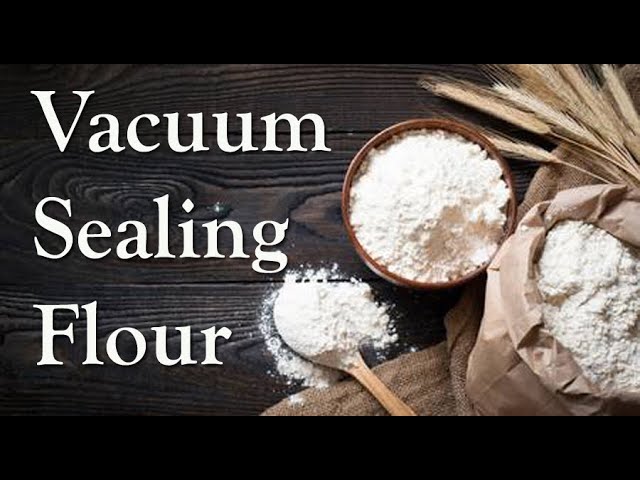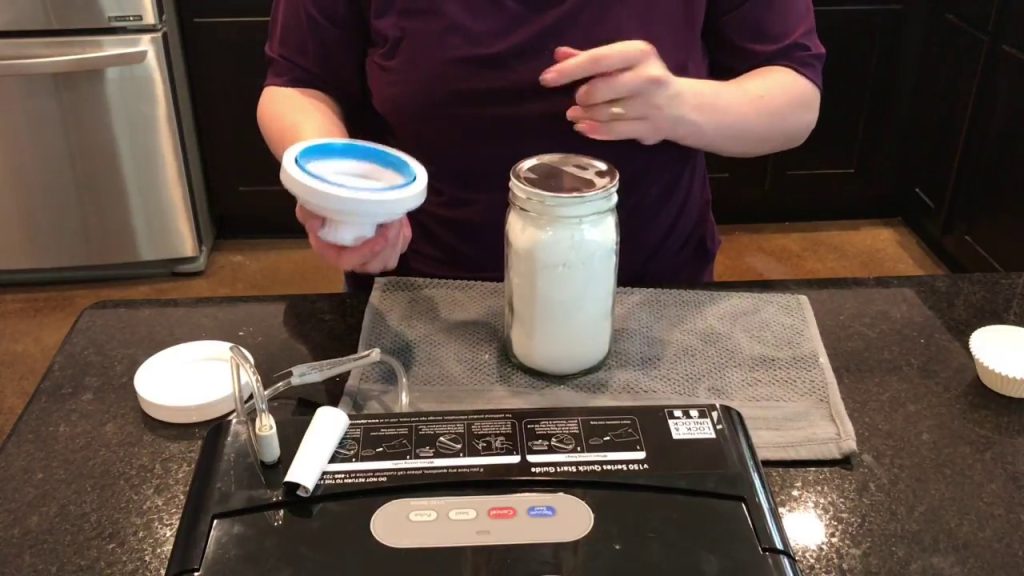Vacuum sealing is a great way to extend the shelf life of ingredients like flour. Vacuum sealing can keep your flour fresh and help you avoid having to throw away the unused portion of an open bag. But before you get started, there are a few important points to bear in mind when it comes to vacuum-sealing flour. Let’s take a look at how you can ensure that your flour stays as fresh as possible for as long as possible.

Table of Contents
Choose the Right Bag Material
When it comes to vacuum-sealing flour, not all materials are created equal. You need to make sure that you use the right type of bag because different materials will affect how well your food is sealed and its overall longevity.
The best material for vacuum sealing flour is polyethylene (PE), either low-density or high-density, as this material has excellent barrier properties and is oxygen-proof, water vapor-proof, and grease-proof.
It’s also tear-resistant and has excellent barrier properties against moisture, heat, odors, flavors, gases, oils, and fat—all of which are important characteristics when it comes to preserving your food items over time.
Prepare the Flour Before Sealing
Before you seal your flour, make sure that it’s properly prepared by sifting out any clumps that might be present in the bag or container. Clumps can cause some pockets of air within the sealed bag or container which could lead to premature spoilage of your food item eventually.
If possible, try to break up any clumps with a spoon or other tool before vacuum sealing so that all parts of the flour are evenly distributed inside the sealed package. Doing this will ensure maximum shelf life for your product.
Handle with Care When Sealing
Lastly—and most importantly—when you’re ready to seal your bags or containers with your vacuum sealer machine, be sure to handle them carefully as too much force can damage them and/or cause them not to seal completely.
Try using a lower speed setting on your machine if necessary so that everything seals perfectly without compromising the integrity of the bag or container itself.
Don’t forget about any special instructions included with your machine either; reading these instructions carefully beforehand can help save you time in troubleshooting if something goes wrong during the process!
FAQs
How long does vacuum-sealed food last?
Vacuum-sealed food can last for months and years depending on the type of food and the storage conditions.
Fresh fruits and vegetables stored in a vacuum-sealed bag may last up to 8 weeks, while meat such as ground beef, steak, and poultry may last up to one year if properly sealed.
Vacuum sealing is an effective way to preserve food longer than other methods, such as freezing or canning. Vacuum sealing also allows for more efficient storage of food, reducing wastage.
To ensure the best results from vacuum-sealing your food, it is important to regularly inspect the bags for any signs of leakage and always store them in a cool and dry environment away from direct sunlight. Properly sealed food stored in a vacuum-sealed bag can help you save time and money, while also allowing for more efficient storage of food items.
Additionally, it is important to note that there are some foods that cannot be vacuumed and sealed due to their fragility or tenderness. These include items such as eggs, mushrooms, and fish. In addition, some foods are not recommended to be vacuum sealed due to their tendency to spoil quickly (e.g., milk).
Finally, it is important to note that a vacuum-sealing machine will need regular maintenance in order for it to continue working properly over the long term. With proper care and maintenance, a vacuum-sealing machine can help you preserve food for longer periods of time.
In conclusion, vacuum sealing is an effective way to extend the shelf life of food items and reduce wastage. Proper storage and maintenance are essential in order to ensure that your vacuum-sealed foods will last as long as possible.
Read more: Can You Vacuum Seal Bread?
How long will flour last in mylar bags?
The shelf life of flour stored in mylar bags depends on a variety of factors such as the type of flour, the amount of moisture it contains, and the environment in which it is stored.
White all-purpose flours like cake and pastry flours can last up to two years when stored in an airtight container or mylar bag in a cool, dry place.
Whole wheat flour may not last as long — typically up to one year.
Storing flour in the refrigerator or freezer extends its shelf life even longer, up to 3-4 years for all-purpose and 6 months for whole wheat flour.
For best results, check the expiration date printed on the product packaging and follow the storage recommendations to ensure that you get the most out of your flour.
It is also important to note that even if flour has exceeded its recommended shelf life, it may still be safe to eat if stored properly. To test for freshness, smell the flour – if it smells off or stale, discard it. Additionally, check for any signs of mold or insects before using the flour.
If you don’t plan on using your store-bought flour in a timely manner, consider transferring it to an airtight container or mylar bag and freezing it to extend its shelf life.

Conclusion
Vacuum sealing is an effective way to extend the shelf life of ingredients like flour while keeping them fresh and safe from spoiling quickly due to exposure to air and moisture elements. Choosing appropriate bag materials made out of polyethylene (PE) instead of other plastic materials, preparing your product before placing it into bags/containers for storage purposes by breaking up any clumps present in advance, and handling with care when utilizing a vacuum sealer machine on bags/containers containing food items such as flour–you can ensure maximum shelf life while avoiding potential spoilage issues caused by improper preservation techniques down the line! With careful attention paid upfront during this process–your stored items should remain fresh for quite some time afterward!
References:








